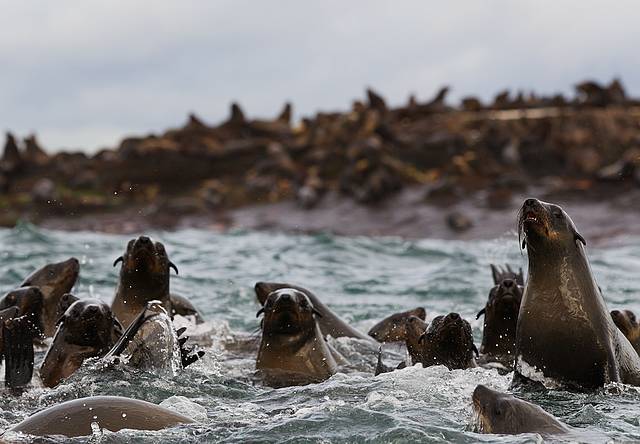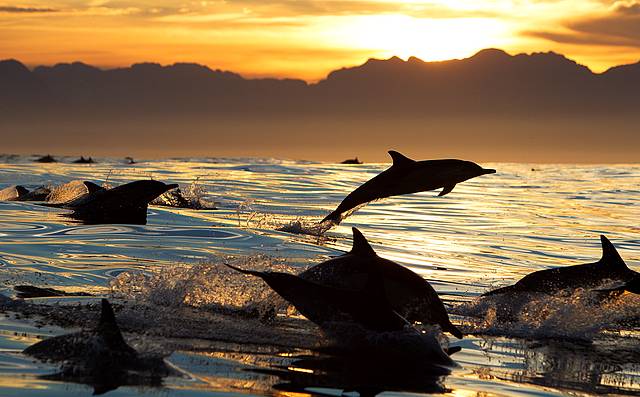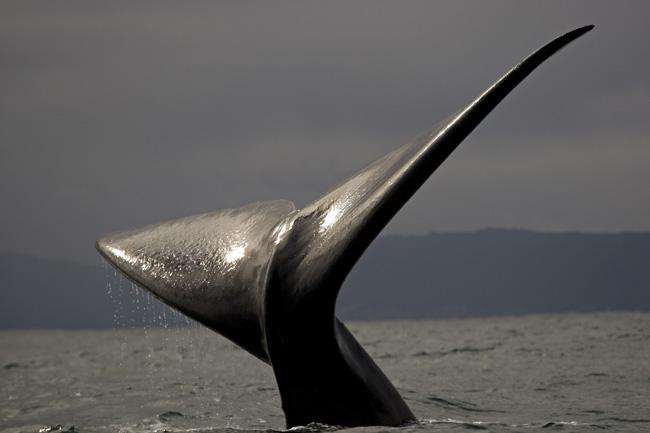The Independent's journalism is supported by our readers. When you purchase through links on our site, we may earn commission.
Bite Club: a search for South Africa’s other Big Five
The country's land mammals draw crowds to wildlife reserves and national parks, but there are fearsome predators lurking just outside Cape Town, as James Litston discovered on a waterborne safari in False Bay
.jpg)
It’s the smell that hits us first as we approach downwind of the offshore rocks: an acrid, noxious, inescapable stench. Undeterred, our boat ventures forward, following a frothy slick being borne from the rocks by the current. As we get closer, a raucous cacophony of braying, barking and bleats comes into earshot. It’s a seal colony – our first brush with wildlife on this alternative “Big Five” safari.
Much of Africa’s tourism is driven by its wildlife, and safaris offering sightings of the so-called “Big Five” are the most in-demand of all. But while lions, rhinos, elephants, leopards and buffalo can be found in many spots in South Africa, I’ve come to Cape Town with a different agenda. Rather than heading inland to the bush, this safari experience is out in False Bay, where we’ve come to seek out Africa’s top marine predators – penguins, dolphins, seals, whales and great white sharks.
In terms of ocean wildlife, False Bay is hard to beat. Its 420 square miles of water is framed by soaring topography, with the Hottentots Holland Mountains on one side and a finger of land reaching down to Cape Point on the other. Cape Point is where the correspondingly cold and warm waters of the Atlantic and Indian Oceans meet, creating conditions where sea life flourishes.

The abundance of fish draws predators in many shapes and sizes, and here at appropriately named Seal Island, I’m eyeballing one of one of the most common. Our boat slows to a crawl as it nears the rocks, where 60,000 Cape fur seals are busily rearing their young. It’s a riot of adult males sparring for dominance while hungry pups call for their mothers. Their combined, fishy excrement is the source of that pungent slick.
It’s June and it’s winter in Cape Town, which may seem an odd time to visit. Somewhere behind us, thick cloud shields Table Mountain from view. Only occasional shafts of sunlight pierce through from the heavens, and we’re wearing layers to withstand the chill on the breeze. But while this may be slow season for tourists, it’s the best time to see False Bay’s predators. At this time of year, there are whales in good numbers, African penguins are courting, and the half-grown seal pups that we’re cooing over are learning how to swim. For some, the adventure will be brief. We’re not the only visitors to Seal Island.
Great white sharks have also followed the slick and Seal Island is basically a big, open buffet; few other sites hold such promise of spotting these mighty predators. Chris, our guide, explains how the stretch of deep water on this side of the island is the most dangerous place in the world to be a seal. It’s what he calls the “strike zone”; if you’ve ever seen TV footage of great white sharks breaching, leaping clear of the water in pursuit of a seal, it was probably filmed right here.

Many shark-watching trips “chum” the water to tempt the animals closer, but the seals’ rancid slick performs the same function. Now it’s just a waiting game. As we scan the water for activity, Chris explains how False Bay’s great whites are the largest in South Africa, and tells tales of various hunting behaviours he’s witnessed at this spot. It’s an ominous thought, especially given our boat’s tiny stature; and it certainly adds to the frisson of anticipation.
But today, perhaps the sharks aren’t hungry. The seals seem relaxed as they play in the swell, suggesting their predators are elsewhere. After a while, Chris cuts our losses and steers away from the rocks towards open sea.
As we skim across the bay, sunshine finally breaks through the clouds. As if to welcome it, a pod of common dolphins, at least 100 strong, appears out of nowhere and races the boat, taking turns to ride the bow wave. They leap and back-flip obligingly as they go, some almost within touching distance. We travel with them for several minutes, mesmerised by their antics. But as they begin to outpace us, Chris brings the boat to a stop, his keen eyes already locked on another species.

He points to where a huge, dark body is breaking the surface, quickly followed by another. Our luck is in – it is a Southern right whale mother and calf. They sink out of sight, but the strokes of their tails leave telltale, circular “footprints” on the water as they pass under the boat.
The population of right whales – they were once considered the “right” species to hunt – was decimated in years gone by. But legal protection has seen them rebound, and they’re frequently seen here in winter. In fact, we spy more later, swimming close to the shore at Boulders Beach, which is where we head after the tour for close-ups with the last of False Bay’s Big Five.
Boulders Beach is named for its striking jumble of weathered rocks, among which lives a colony of penguins. In summer, this is a tourist hotspot, but today we are almost alone. We follow a boardwalk to where groups of the birds are gathered on the sand, immaculate in their black and white plumage like gentlemen dressed for a ball.
We survey their waddling until our eyes are dragged seawards as another whale passes close inshore. Somewhere out there, too, sharks are lurking in the depths; and although it’s a shame to have missed them today, we’re certainly not disappointed. Four of the Big Five is pretty good going – and we now have a reason to come back next winter.
Travel essentials
The writer travelled with British Airways (0344 493 0787; ba.com), which flies regularly from Heathrow to Cape Town.
Kenwood Travel (0207 749 9242; kenwoodtravel.co.uk) offers packages to South Africa: BA flights with five nights’ B&B at Belmond Mount Nelson cost from £1,299 per person.
A half-day False Bay safari costs from £95 per person with Apex Predators (00 27 21 788 1863; apexpredators.com)
Cape Town Tourism: capetown.travel
Join our commenting forum
Join thought-provoking conversations, follow other Independent readers and see their replies
Comments
Bookmark popover
Removed from bookmarks